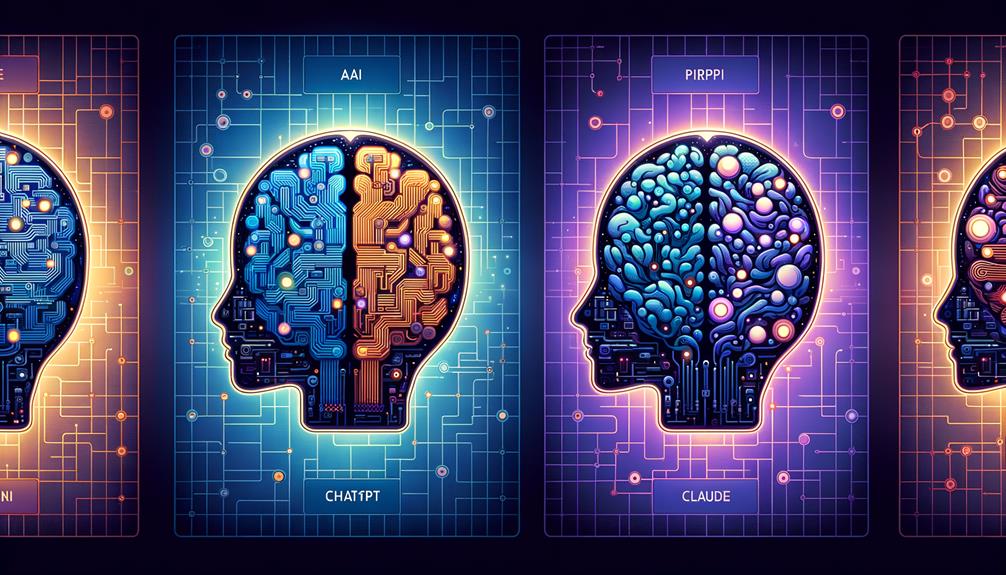

Probablemente esté comparando ChatGPT, Claude y Perplexity para determinar cuál es el mejor modelo de IA para sus necesidades. Cada uno destaca en áreas específicas: Perplexity es ideal para la investigación y el análisis de datos, ChatGPT brilla en la redacción de correos electrónicos y la creación de contenidos para redes sociales, mientras que Claude domina las aplicaciones conversacionales. Para elegir la herramienta adecuada, tienes que entender sus distintos puntos fuertes y capacidades. Aunque los tres modelos comparten algunas similitudes, sus principales casos de usoestilos de interacción y características principales difieren enormemente. A medida que explore estas diferencias, descubrirá cuál es el modelo que mejor se adapta a sus necesidades específicas y liberará todo el potencial de la IA.
Al evaluar Modelos de IAdescubrirá que cada uno destaca en distintos casos de uso principalesy comprender estos puntos fuertes es clave para elegir la herramienta adecuada a sus necesidades.
Está buscando un inteligencia artificial[1] solución que se adapte a sus objetivos, y saber dónde brilla cada modelo puede marcar la diferencia.
Perplexity AI es su solución para investigación y análisis de datos...proporcionando información precisa, información citada como fuente perfecto para contextos académicos y profesionales.
ChatGPT, por su parte, es una herramienta versátil para redactar correos electrónicos, crear contenidos para redes sociales y participar en cliente[2] servicio.
Mientras tanto, Claude domina las aplicaciones conversacionales y la participación de los usuarios, lo que le ha valido el título de "rey de los contenidos".
Si comparamos los estilos de interacción de los modelos de IA, veremos que cada uno destaca por su propia forma de atraer a los usuarios y proporcionarles información. Perplexity AI hace hincapié en las interacciones estructuradas y centradas en la información. Por otro lado, ChatGPT brilla por su estilo conversacional, mientras que Claude también se centra en la IA conversacional. Se aprecia una clara diferencia en la forma en que cada modelo aborda el diálogo.
| Modelo de IA | Estilo de interacción |
|---|---|
| Perplejidad AI | Estructurado y centrado en la información |
| ChatGPT | Conversacional y similar al ser humano |
| Claude | Conversacional con un enfoque de diálogo único |
Observará que el estilo de interacción de cada modelo está diseñado para destacar en áreas específicas. Al comparar estos estilos, comprenderás mejor cómo cada modelo puede satisfacer tus necesidades específicas.
A medida que se exploran las características y capacidades clave de los distintos modelos de IA, surgen puntos fuertes distintivos que diferencian a cada uno en cuanto a funcionalidad y experiencia de usuario.
Notarás que Perplejidad AI destaca por su sólidas capacidades de investigacióncitando a menudo más de 20 referencias y proporcionando acceso a los datos en tiempo real. Esto lo hace ideal para contextos académicos y profesionales en los que es esencial disponer de información actualizada.
ChatGPT, por su parte, ofrece entradas multimodalesque le permite interactuar mediante texto, imágenes y audio.
Claude 3 cuenta con la ventana contextual más grande de 200.000 fichas, lo que le permite procesar más información en una sola conversación.
Mientras tanto, GPT-4[3] brilla con su profundo conocimiento y versatilidadpor lo que resulta adecuado tanto para la generación de contenidos creativos como para tareas complejas de resolución de problemas.
Cada modelo de IA tiene sus puntos fuertes.
Aunque cada modelo de IA cuenta con capacidades impresionantes, sus interfaces y características de accesibilidad desempeñan un papel importante en la configuración de tu experiencia general. Quieres acceder fácilmente a la información, tanto si navegas desde tu ordenador como si lo haces desde tu teléfono.
A la hora de evaluar la experiencia del usuario, hay que tener en cuenta
Ahora que ha evaluado la experiencia de usuario de cada modelo de IA, es hora de sopesar los costes, ya que las estructuras de precios y las opciones de suscripción pueden influir mucho en su decisión. Deberá evaluar el análisis coste-beneficio de cada modelo. Aquí tienes un desglose de las estructuras de precios de cada modelo:
| Modelo | Suscripción mensual | API[4] Acceda a |
|---|---|---|
| Perplejidad AI | $20 | más barato que la suscripción |
| GPT-4 | $20 (GPT-Plus) | más barato que la suscripción |
| Claude 3 | $20 | más barato que la suscripción |
| Géminis Ultra | $10 (Google[5] Uno miembros) | más barato que la suscripción |
| $20 (no miembros) |
Al elegir un modelo de IA, tendrá que evaluar si las ventajas compensan los costes. La estructura de precios puede ser un factor importante a la hora de tomar una decisión.
Tres factores clave que hay que tener en cuenta a la hora de evaluar las capacidades conversacionales de un modelo de IA son su memoria, su capacidad de atención y su habilidad para no desviarse del tema; todos ellos se ven directamente afectados por sus capacidades de ventana contextual.
Probablemente se pregunte qué diferencia a estos modelos. He aquí tres puntos clave sobre los que reflexionar:
Al evaluar Modelos de IAcomparar sus puntos fuertes, capacidades y estructuras de precios es esencial para determinar qué modelo se adapta mejor a sus necesidades y aplicaciones específicas.
Querrá contemplar la excepcional solución de Perplexity AI acceso a los datos en tiempo real y capacidades de navegación web, lo que lo hace ideal para tareas orientadas a la investigación.
Por otro lado, la versatilidad de GPT-4 en tareas generales de IA y generación de contenidos creativos puede satisfacer sus necesidades de creación de contenidos.
Mientras tanto, la ventana contextual más grande de Claude 3 brilla en aplicaciones conversacionales complejas y creación de contenidos.
Cada modelo tiene un precio aproximado de $20/mes, por lo que tendrás que sopesar su características únicas con sus prioridades.
Analizando estos factores, hará una decisión informada sobre qué modelo se adapta mejor a sus objetivos.
Cada modelo tiene sus puntos fuertes, así que elige bien.
A medida que avanza el desarrollo de la IA, cabe esperar mejoras significativas en las capacidades de los modelos, sobre todo con el lanzamiento previsto de GPT-5, que promete superar la oferta actual.
Veremos casos de uso más sofisticados, como la generación de contenidos mejorados, una IA conversacional mejorada y herramientas de productividad más eficientes.
He aquí tres áreas clave hacia las que se dirige el desarrollo de la IA:
Estás decidiendo entre dos modelos de IA, pero ¿cuál es mejor? Para tomar una decisión con conocimiento de causa, vamos a realizar una comparación de rendimiento. Tendrás en cuenta factores como la precisión, el tiempo de respuesta y la adecuación a la tarea para determinar el ganador.
Está utilizando Perplexity AI, que emplea una arquitectura de modelos avanzada, incluyendo GPT-4 y Claude 3. Puedes elegir el modelo que mejor se adapte a tus necesidades, aprovechando sus puntos fuertes para obtener respuestas exhaustivas y acceso a los datos en tiempo real.
A la hora de la verdad, Claude es ideal para aplicaciones conversacionales en las que la participación del usuario es clave, mientras que ChatGPT lo es para tareas creativas, por lo que la comparación de modelos es un paso esencial a la hora de elegir la herramienta adecuada".
Te preguntarás si Perplexity utiliza Claude, y la respuesta es sí, integra Claude 3, que ofrece capacidades conversacionales avanzadas. Sin embargo, también debes tener en cuenta los retos de integración que conlleva combinar diferentes modelos de IA.